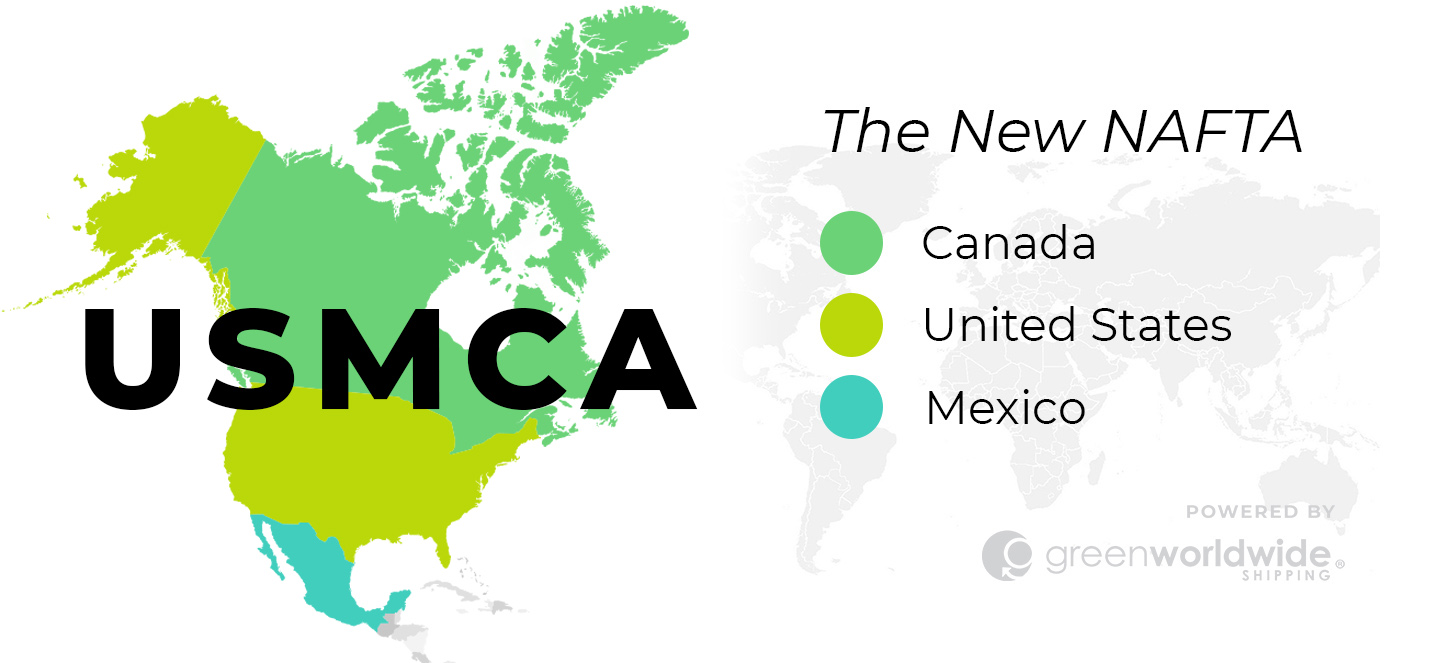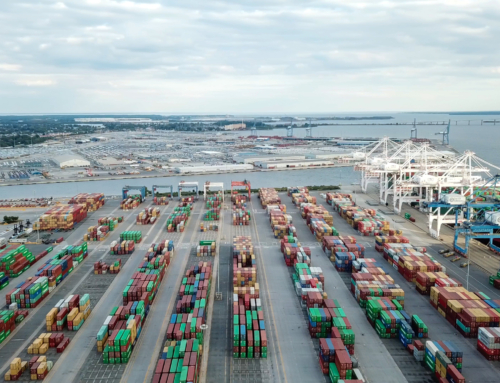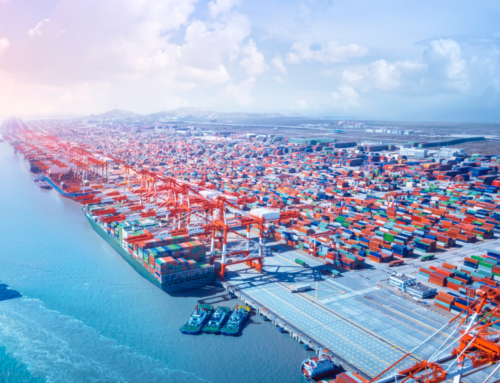Starting July 1, 2020, the United States, Canada, and Mexico will no longer be partners in the North American Free Trade Agreement (NAFTA). Instead, the three neighboring countries will begin implementation of a new program incepted back in 2018, the U.S.-Mexico-Canada Agreement (USMCA).
The North American Free Trade Agreement (NAFTA) is a treaty entered into by the United States, Canada, and Mexico that went into effect on January 1, 1994. Tariffs were eliminated progressively and all duties and quantitative restrictions, with the exception of those on a limited number of agricultural products traded with Canada, were eliminated by 2008.
Significant impacts to the U.S. economy will come from changes to rules of origin as they apply to the automotive industry by increasing regional value content (RVC) requirements that would encourage more U.S. production of auto parts and increased security for international data transfer provisions by prohibiting the forced localization of computing facilities and restrictions to cross-border data flows.
Because the USCMA is based in NAFTA, which already eliminated most duties and non-tariff barriers to trade, the new agreement is focused on resolving remaining issues impacting economic progress, such as:
- workers’ rights;
- consistent regulations from country-to-country; and
- deterring barriers to future trade and investment.
In June, the Office of the U.S. Trade Representative released details of how the transition will take place as well as interpretation guidelines for new rules of origin requirements.
U.S. CUSTOMS AND BORDER PROTECTION HAS PUBLISHED THE FOLLOWING FAQS AS A RESOURCE FOR BUSINESSES:
What is the U.S. – Mexico – Canada Agreement (USMCA)?
The U.S. – Mexico – Canada Agreement (USMCA) is a trade agreement between the three named countries. When implemented, it will replace the North American Free Trade Agreement (NAFTA).
Please note: in Canada, this agreement is referred to as the Canada – United States – Mexico Agreement (CUSMA); in Mexico, this agreement is referred to as Tratado entre México, Estados Unidos y Canadá (T-MEC). All three names refer to the same trade agreement.
When will the U.S. – Mexico – Canada Agreement (USMCA) be implemented?
The USMCA will enter into force on July 1, 2020.
For merchandise entered into commerce on or before June 30, 2020, NAFTA rules will continue to apply.
Is there a required certificate of origin / form for the U.S. – Mexico – Canada Agreement (USMCA)?
The U.S. – Mexico – Canada Agreement (USMCA) does not require a specific certificate of origin as does the North American Free Trade Agreement. CBP Form 434 is not mandatory under the USMCA.
A claim for preferential treatment under the USMCA should contain nine minimum data elements. These data elements are set out in the USMCA’s Annex 5-A (Minimum Data Elements). The data elements must indicate that the good claiming preferential treatment originates and meets the requirements of USMCA Chapter 5. This information may be provided on an invoice or any other document. The information must describe the originating good in sufficient detail to enable its identification and meet the requirements as set out in the Uniform Regulations.
For more information see Chapter 5 Origin Procedures, Article 5.2 and Annex 5-A.
Additional guidance materials will be published by U.S. Customs and Border Protection in advance of the USMCA’s entry into force.
How should the trade community prepare to comply with the new U.S. – Mexico – Canada Agreement (USMCA) rules and requirements?
U.S. Customs and Border Protection (CBP) is actively preparing for U.S. – Mexico – Canada Agreement (USMCA) implementation. CBP is planning for needed changes to our automated systems, regulations, training for personnel, and outreach to private sector stakeholders.
As CBP prepares for implementation and the publishing of regulations and compliance guidance, the trade community should read and review the following materials:
-
- U.S. – Mexico – Canada Agreement Text
- United States-Mexico-Canada Agreement Implementation Act (Pub. Law No. 116-113)
- United States-Mexico-Canada Agreement: Likely Impact on the U.S. Economy and Specific Industry Sectors; ITC Publication No. 4889; Investigation No. TPA 105-003
CBP will distribute compliance guidance and other information in advance of entry-into-force.
How long will the U.S. – Mexico – Canada Agreement (USMCA) remain in force?
The U.S. – Mexico – Canada Agreement (USMCA) requires a “joint review” of the Agreement six years after entry-into-force. At this joint review, the Parties will review the operation of this Agreement, review any recommendations for action submitted by a Party, and decide on any appropriate actions.
For more information, see USMCA, Article 34.7: “Review and Term Extension”.
What is the definition of textile or apparel goods under USMCA?
The USMCA defines a textile and apparel good as “textile or apparel good classified in HS subheading 4202.12, 4202.22, 4202.32, or 4202.92 (luggage, handbags and similar articles with an outer surface of textile materials), heading 50.04 through 50.07, 51.04 through 51.13, 52.04 through 52.12, 53.03 through 53.11, Chapter 54 through 63, heading 66.01 (umbrellas) or heading 70.19 (yarns and fabrics of glass fiber), subheading 9404.90 (articles of bedding and similar furnishing), or heading 96.19 (babies diapers and other sanitary textile articles).”
Click here to see Chapter 1 Initial Provisions and General Definitions.
What is CBP’s role in the implementation of the U.S. – Mexico – Canada Agreement (USMCA)?
The USMCA will replace the North American Free Trade Agreement (NAFTA). U.S. Customs and Border Protection (CBP) is the United States’ lead implementing agency with respect to the USMCA. To this end, CBP has launched an internal USMCA Coordination Center, which will ensure, coordinate, and guide the implementation of the USMCA for CBP and our stakeholders.
CBP will communicate with trade stakeholders throughout the implementation process as we transition from NAFTA to USMCA.
What provisions has CBP put in place to engage with the private sector during this transition phase?
On March 16, 2020, CBP launched a working group for the USMCA under the Commercial Operations Advisory Council (COAC). Additional information on COAC can be found at: https://www.cbp.gov/trade/stakeholder-engagement/coac.
In addition, CBP has created a webpage for USMCA information on CBP.gov, where compliance guidance, announcements, points of contact, and FAQs will be posted and kept updated. For more information see https://www.cbp.gov/trade/priority-issues/trade-agreements/free-trade-agreements/USMCA.
CBP will also disseminate information regarding specific commodities through the appropriate Centers of Excellence and Expertise. Additional information on these plans is pending.
How will the trade communicate with CBP during the implementation of the USMCA?
On March 16, 2020, CBP launched a working group for the U.S. – Mexico – Canada Agreement (USMCA) under the Commercial Operations Advisory Council (COAC). Additional information on COAC can be found at https://www.cbp.gov/trade/stakeholder-engagement/coac.
In addition, CBP’s USMCA Coordination Center will support CBP’s cross-agency and interdepartmental efforts to implement the Agreement.
Importers should communicate with their assigned Centers of Excellence and Expertise regarding their specific importations. For more information see https://www.cbp.gov/trade/centers-excellence-and-expertise-information.
CBP will distribute compliance guidance and other information to the private sector in advance of entry into force.
How will the transition from NAFTA to USMCA work?
NAFTA rules will remain in effect until the USMCA enters into force.
For automotive products under headings 87.01 through 87.08, there is a transitional period for up to three years, and alternative staging regime options (coordinated by the U.S. Trade Representative) for up to five years.
Additional compliance guidance for the USMCA’s automotive rules of origin is pending. For more information see USMCA Ch. 4 – Rules of Origin.
For all other commodities, USMCA rules will replace NAFTA rules on the date the Agreement enters into force.
There will be a new Special Program Indicator (SPI) for USMCA claims. NAFTA’s SPI Indicator will be accepted for claims on merchandise that are entered prior to the USMCA’s entry into force.
What is the role of the Department of Labor in USMCA implementation and enforcement?
CBP is coordinating with the U.S. Department of Labor on the verification process of USMCA claims on automotive goods. The rules of origin for such goods include the new criterion of Labor Value Content, which requires that a specified percentage of a vehicle’s value be derived from manufacturing facilities that pay an average wage of at least $16 USD per hour.
The U.S. Department of Labor will assess the wage practices of the manufacturing facilities involved in the production of such vehicles and their components. This information will be used in CBP’s calculation of Labor Value Content. Additional guidance on compliance with this new requirement is pending.
What should the Trade community do to comply with the new USMCA rules and requirements?
CBP will ensure implementing instructions and other compliance guidance are available in advance of the Agreement entering into force.
In the interim, please read and review the Agreement text to determine if your import qualifies as an originating good under the USMCA. Resources include:
-
- U.S. – Mexico – Canada Agreement Text
- United States-Mexico-Canada Agreement Implementation Act (Pub. Law No. 116-113)
- United States-Mexico-Canada Agreement: Likely Impact on the U.S. Economy and Specific Industry Sectors; ITC Publication No. 4889; Investigation No. TPA 105-003
Are there any changes that the textile industry should be aware of?
Revised tariff shift rules maintain the basic concepts established under NAFTA with a few modifications. These rules allow manufacturers to use textile inputs not generally available in North America (such as rayon fibers and visible lining fabric).
The USMCA modifies the chapter rules for goods classified in HTS chapters 61 and 62.
The USMCA increases the de minimis percentage of non-originating inputs allowed in qualifying goods from 7 to 10 percent (within the overall 10% cap, the total weight of elastomeric content may not exceed 7%).
Other changes under the USMCA require that sewing thread, pocketing fabric, narrow elastic bands, and coated fabric used in the production of apparel be made in North America in order for those products to be treated as originating (under the current NAFTA, these items can be sourced from outside the region – USMCA ensures these secondary components originate within the region).
The USMCA establishes a Textiles chapter for North American trade, including textile-specific verification and customs cooperation provisions that provide new tools for strengthening customs enforcement and preventing fraud.
The USMCA reduces some TPLs for US imports from Canada and Mexico while substantially increasing TPLs for US exports to Canada of apparel and other finished textile goods.
Which industries will have the most impact from the changes from NAFTA to the USMCA?
The USMCA contains new criteria for the Rules of Origin for automotive and automotive part imports. These new criteria include increases in the regional value content, new North American steel and aluminum procurement requirements, and labor value content. These new criteria will require additional attention by importers to ensure compliance. For more information see USMCA Ch. 4 – Rules of Origin
Other impacted industry groups include manufactured goods, textile and apparel, and agricultural good sectors. Additional information is available via the International Trade Commission.
United States-Mexico-Canada Agreement: Likely Impact on the U.S. Economy and Specific Industry Sectors; ITC Publication No. 4889; Investigation No. TPA 105-003
What commodities do the Tariff Rate Quotas (TRQs) impact?
The USMCA includes provisions to exclude a certain quantity of Mexican and Canadian automobiles and automobile parts from any Section 232 trade remedy actions. For more information see USMCA Side Letters at the links below:
For agricultural goods, the USMCA maintains NAFTA’s zero-tariff treatment and includes adjustments to tariff-rate quota volumes to provide greater U.S. access to Canadian dairy, poultry, and egg markets.
For more information see USMCA Ch. 3 – Agriculture
What are the changes involving remanufactured goods?
The USMCA prohibits Parties from applying unnecessary restrictions on imports of remanufactured goods. If a Party adopts or maintains a prohibition or a restriction on a used good, it shall not apply the measure to a remanufactured good.
For more information see USMCA Ch. 4 – Rules of Origin, Article 4.4
What are the new criteria for imported automobiles and automotive parts?
The USMCA requires new criteria for automotive goods that are not present in NAFTA, including:
-
- Increased Regional Value Content from 62.5% to 75%, increased in stages over a period three years.
- Labor Value Content (40-45% percent of the value of the imported automobile must be sourced from manufacturing facilities where workers earn at least $16 USD per hour. The U.S. Department of Labor will be performing the assessment of manufacturing facility eligibility, with CBP determining value of the parts, the overall automobile, and the overall Labor Value Content determination.
- Steel and Aluminum (At least 70% of a vehicle producer’s annual steel and aluminum procurement must originate from North America).
CBP will issue compliance guidance in advance of implementation. For more information select USMCA Ch. 4 – Rules of Origin.
How will verifications and audits of automotive goods take place?
CBP will verify compliance of the USMCA’s automotive rules of origin. CBP will work with the U.S. Department of Labor on the calculation of Labor Value Content.
CBP is a participant on the Committee on Trade In Automotive Goods Under Section 202a of the USMCA Implementation Act, led by the U.S. Trade Representative, to finalize processes under the USMCA for automotive goods. (For more information see Executive Order).
Additional guidance will be distributed in advance of implementation.
Will USMCA change any enforcement mechanisms?
The USMCA contains new provisions to combat AD/CVD evasion, commitments to interdict transshipped IPR infringing goods, prohibitions on the importation of goods sourced from forced labor, and requirements to prevent illegal taking of wild flora and fauna (including timber).
New enforcement tools will expand confidential trade data sharing; increase joint analysis, investigations and operations; and facilitate facility verification visits to assess production capacity.
For more information see USMCA Ch. 7 – “Customs Administration and Trade Facilitation”
How will CBP enforce the new Environmental and Labor requirements in USMCA?
Many of the provisions of the USMCA are awaiting final implementation guidance from the U.S. Trade Representative or are under development.
Will CBP still accept CBP Form 434 (North American Free Trade Agreement (NAFTA) Certificate of Origin) for U.S. – Mexico – Canada Agreement (USMCA) claims for preferential treatment?
No. The USMCA does not require a specific certificate of origin form. Rather, it requires nine specific data elements, which can be presented in any format, similar to other more modern trade agreements that were implemented subsequent to NAFTA [See USMCA Ch. 5 ‘Origin Procedures,’ Art. 5.2 (Claims for Preferential Tariff Treatment) and Annex 5-A (Minimum Data Elements)]. To avoid confusion, the CBP Form 434 will no longer be accepted for claims of preferential treatment under the USMCA. Even if the rule of origin for the subject good is the same under NAFTA and USMCA and all of USMCA’s required data elements are present on Form 434, the good needs to be recertified under USMCA.
May USMCA be claimed on a U.S. good?
Yes, USCMA claims may be made on a good of U.S. origin, provided it satisfies its applicable rule of origin and all other requirements of the Agreement have been met.
How can I obtain a copy of the new USMCA certificate of origin form?
There is no official certificate of origin for USCMA, as there was for NAFTA. USCMA requires a “certification of origin.” Any format is acceptable, provided it contains the following nine minimum data elements set out in USCMA, Annex 5-A:
-
- Importer, Exporter, or Producer Certification of Origin
- Certifier
- Exporter
- Producer
- Importer
- Description and HS Classification of the Good
- Origin Criteria
- Blanket Period (if applicable)
- Authorized Signature and Date
For more information on certification requirements and the data elements listed above, please see USMCA, Article 5 and Annex 5-A, available at the U.S. Trade Representative website.
* https://www.cbp.gov/trade/priority-issues/trade-agreements/free-trade-agreements/USMCA/FAQs
Published on U.S. Customs and Border Protection (https://www.cbp.gov)
For a detailed of USCMA regulation by industry, visit the following resources:
- USMCA-Agriculture
- USMCA-Autos and Auto Parts
- USMCA-Digital Trade
- USMCA-Energy
- USMCA-Environment
- USMCA-IP
- USMCA-Labor
- USMCA-NME
- USMCA-SME
- USMCA-Textiles
- USMCA-Monitoring and Enforcement
As Green continues to monitor the situation, stay up-to-date on freight news by following us on Facebook, Twitter, and LinkedIn. For continuous updates, make sure to check out our website at greenworldwide.com.






